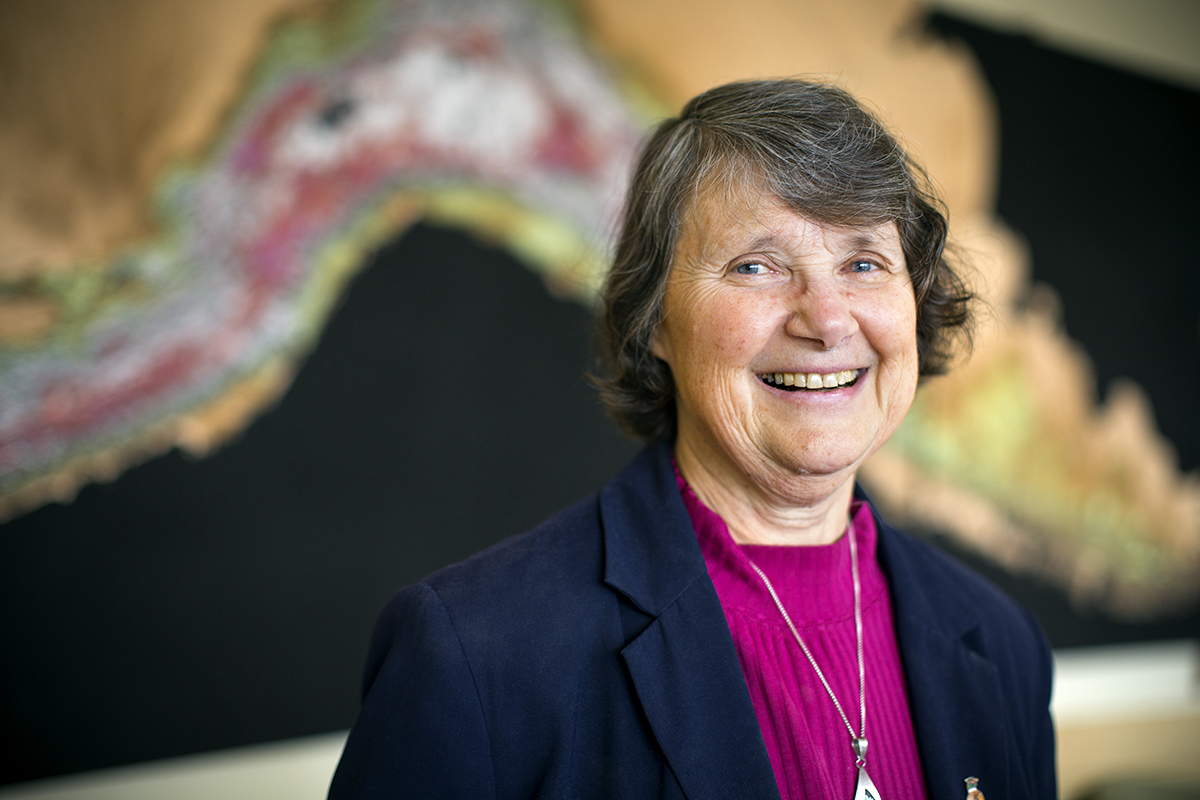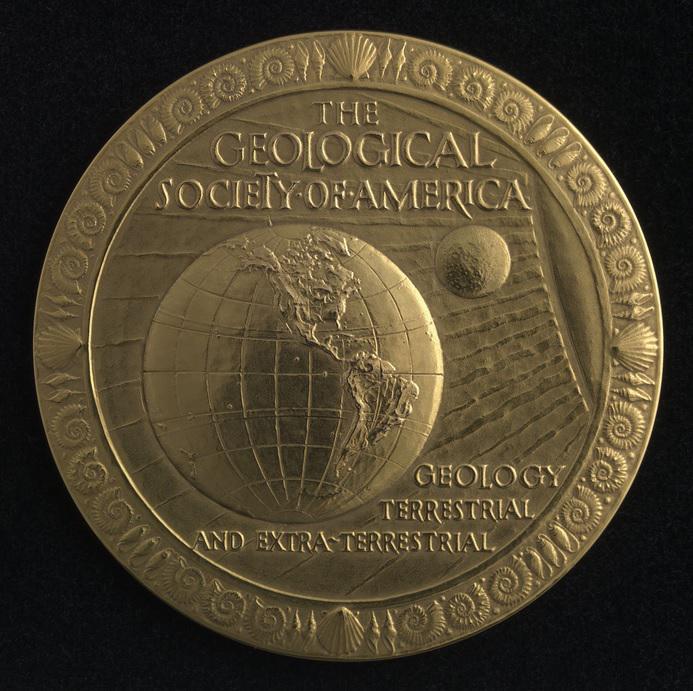EAS Alumni Magazine October 2023 Suzanne Mahlburg Kay wins 2023 Penrose Medal
By Chris Dawson
Longtime Cornell EAS faculty member Suzanne Mahlburg Kay has been awarded the 2023 Penrose Medal by the Geological Society of America (GSA). Kay, who is the William and Katherine Snee Professor of Geological Sciences Emeritus, was cited for “eminent and impactful scientific contributions throughout her career, with breakthrough research on the fundamental tectonic processes responsible for crustal and mantle genesis along convergent margins.”
The Penrose Medal is just the latest honor of many Kay has earned during her almost-50-year career as a geologist studying the origin and evolution of the continental crust. She is a Fellow of the Mineralogical Society of America, the American Geophysical Union, and the Geological Society of America, as well as a Member of the National Academy of Sciences of Argentina. She also held the post of president of the Geological Society of America in 2013 and 2014.
Kay has published close to 400 papers and her works have been cited more than 22,000 times by other researchers.
 And yet when she talks about her career, Kay focuses as much on her collaborators as she does on herself. “When I started at Cornell I thought I’d died and gone to heaven. The department was like a family and Jack Oliver was an incredible leader—we built something truly special.” By “we” Kay means Department Chair Jack Oliver, and fellow professors Bryan Isacks, Don Turcotte, Rick Allmendinger, Teresa Jordan, and Robert Kay—Suzanne’s husband.
And yet when she talks about her career, Kay focuses as much on her collaborators as she does on herself. “When I started at Cornell I thought I’d died and gone to heaven. The department was like a family and Jack Oliver was an incredible leader—we built something truly special.” By “we” Kay means Department Chair Jack Oliver, and fellow professors Bryan Isacks, Don Turcotte, Rick Allmendinger, Teresa Jordan, and Robert Kay—Suzanne’s husband.
Kay first came to Cornell after earning her Ph.D. at Brown University and holding a postdoctoral fellowship at UCLA for a year. She arrived in Ithaca in 1976 to begin a postdoctoral position with COCORP—the hugely influential Consortium for Continental Reflection Profiling which used reflection seismology in studies of tectonics and the Earth’s crust. Kay has been at Cornell ever since, as a research associate, senior research associate, associate professor, full professor, and then as the William and Katherine Snee Professor of Geological Sciences.
Early in her career, much of Kay’s field work was done in the Aleutian Island chain that arcs out into the Pacific Ocean south and west of mainland Alaska. One of these research trips to the island of Adak doubled as a honeymoon for Suzanne Mahlburg and her newlywed husband Robert Woodbury Kay, a long-time geochemist and professor at Cornell.
When Kay talks about her Aleutian field work, her description makes it clear the technology then available to researchers was very different from what they have today. “We weren’t dropped off by helicopter and there was no GPS. We hiked in with backpacks and crude topo maps the Army had made back in World War II,” Kay said with a smile. And then she added with a chuckle, “a lot of the time we were wandering around in the fog just hoping not to get lost.”
A guiding question for much of her career has been “How does the Earth make and recycle continental crust?” Samples and data gathered over several years in the Aleutians and later in the Andes of South America led to what is arguably Kay’s most influential paper, “Delamination and delamination magmatism,” (published in 1993 in the journal Tectonophysics), which gives a satisfying partial answer to this huge question. In this paper, Kay explains that under certain conditions portions of the lowermost continental crust and mantle lithosphere can break away from the upper continental crust and sink into the asthenosphere.
In the 1980s Kay was invited to join a team that included her Cornell colleagues Teresa Jordan and Rick Allmendinger as well as Argentine geologist Victor Ramos and Chilean geologist Constantino Mpodozis, among others. This group’s work became the basis of the long-running and scientifically fertile Cornell Andes Project and resulted in many publications and a deeper understanding of the processes at work in the Earth’s crust and mantle. “They needed somebody who knew something about magmatism, so they asked me to go,” Kay said. “It changed my life completely.”
As Kay describes her South American field work and the insights it led her to, she once again pauses to praise the people she was working with. “Victor Ramos became a good friend and through our discussions we influenced each other’s work greatly,” Kay said. “And all through that time and well into the 2000s I looked forward to the regular Friday Andes Seminars that Bryan Isacks launched informally all the way back in 1980. There were so many smart and generous people talking about these ideas—it was very interdisciplinary and helped us all understand these complicated processes better.”
The Andes Project included seismologists, geochemists, petrologists, volcanologists, and experts in surface processes. Each brought something nobody else in the group had, and together they produced hundreds of academic papers, 60 theses, and a greatly expanded understanding of the subterranean and surface processes that shape the Earth.
The Andes Project didn’t just change Kay’s life; it also changed the lives of many of the 175 students from Cornell and elsewhere she brought to Argentina between 1996 and 2015 for summer field work. “That was an incredible experience for me because I had all these challenging young students asking questions all the time. It made me a better teacher and a better researcher.” Kay said. “Many of those students have gone on to productive and successful careers of their own in the field.”
All those trips to the Andes played an essential role in Kay’s own very productive and very successful career in the field. Her first paper with the word “Andes” in the title was published in 1984 and she is still writing papers about the region today. One major aspect of her work today involves identifying chemical evidence for a process called forearc subduction erosion, in an effort to develop a fuller and more nuanced explanation of the current structure of the Andean crust of central and southern South America.
As you might expect from someone with such a deep reservoir of knowledge and love for the field, Kay has several active projects. Her faculty page on the EAS website devotes a full paragraph to what she is doing these days:
“Other Andean projects examine crustal and mantle evolution associated with important episodes of basaltic magmatism and the terrane-accretion history of South America. Currently, the most active of these studies looks at the causes and results of large-scale continental basaltic volcanism in the Patagonian plateaus of southern South America. Present studies are concentrated in the plateau east of the triple junction where the Chile ridge is colliding with the Chile trench. Another project concerns special magmatic events related to periods of supercontinent formation and stability, particularly the formation of granite-rhyolite provinces in the late Paleozoic-early Mesozoic evolution of Gondwana. Finally, studies of basement rocks in the central Andes are relevant to recent questions concerning a possible Laurentian-Gondwana collision. There are also plans to return to studies of the magmatism and crustal and lithospheric evolution of the oceanic Aleutian arc.”
 The final line of the Penrose Medal citation says, “Dr. Kay is truly deserving of the Penrose Medal, as she is among the greatest living geologists in the world.” In talking with Suzanne Mahlburg Kay, it quickly becomes clear that, in spite of being honored with the Penrose Medal for everything she has already accomplished as a geologist, she is not done yet—not by a long shot.
The final line of the Penrose Medal citation says, “Dr. Kay is truly deserving of the Penrose Medal, as she is among the greatest living geologists in the world.” In talking with Suzanne Mahlburg Kay, it quickly becomes clear that, in spite of being honored with the Penrose Medal for everything she has already accomplished as a geologist, she is not done yet—not by a long shot.

